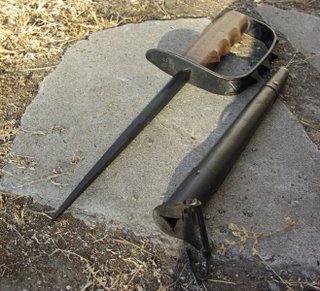Hand-to-Hand.

This is coolbert:
In a previous blog entry, I have mentioned the various forms of martial arts combatatives developed for soldiers of the modern era.
Martial arts forms such as SAMBO, Krav Maga, or Defendu. NOT martial arts forms taught as a way to obtain physical fitness, self-discipline, mental awareness, etc. Martial arts forms designed as a military combatative style. For killing opponents with bare hands if necessary on the battlefield.
All that said, it is important to remember that all that training to kill with the bare hands is rarely, IF EVER used on the modern battlefield. NOT totally so, but extremely rare. Unarmed combatatives as taught [mostly to special operations type units], are just not used but with again, rare, exceptions.
About 80 % of the casualties in modern warfare is the result of automatic weapons fire or artillery. For soldiers to engage in mano-a-mano, one-on-one combat with bare hands or even using edged weapons is a great rarity.
Martial arts combatatives as taught to even special operations troops has more of the effect of a physical training regimen, which builds aggressiveness and self-confidence as a byproduct. Sort of like all the time spent in bayonet training.
Exceptions of course do occur. Even in the First World War [WW1] troops DID on a regular basis engage in hand-to-hand close quarters combat.
This occurred in the form of the trench raid.
Units, of up to battalion size, did carry out with frequency, trench raids. Raiding parties, specially equipped and prepared, did assault, mostly at night, the trenches of the foe, to capture prisoners for interrogation, along with documents of intelligence value. This did happen all the time.
"The tactic had several purposes; to kill or take prisoner enemy troops, to gather intelligence by seizing important documents or enemy officers for interrogation, to keep the enemy 'on his toes' (reducing his morale), and to maintain aggressiveness in troops by sending them on such missions."
Raiders assaulting a section of the enemy trench, did engage in hand-to-hand combat and close quarters battle with the foe. Battle necessitating forms of combat not normally seen in WW1. Soldiers on trench raids would use stealth techniques almost NEVER used in other WW1 style combat. Wool socks worn on the outside of boots, blackened faces, etc.
There could not be and was no need for the normal weapons of WW1, the machinegun and artillery, to be employed during a trench raid.
Soldiers on a trench raid would fight the enemy with:
* Grenades.
* Trench knife.
* Trench club.
* Pistol.
* Western boxing and wrestling techniques.
Some special comment is needed regarding these trench raid weapons.
* Grenades were used extensively for the first time in WW1. Trench raid teams of grenadiers were formed for task specific missions.
"The British bombing team usually consisted of nine men at a time: an NCO, two throwers, two carriers, two bayonet-men to defend the team and two 'spare' men for use when casualties were incurred.
As an attack or raid reached an enemy trench the grenadiers would be responsible for racing down the trench and throwing grenades into each dugout they passed: this invariably succeeded in purging dugouts of their human occupants in an attempt at surrender (often not accepted as they were promptly shot or stabbed)."
* The trench knife was a particularly useful and deadly weapon designed specifically with the trench raider in mind. Again, used in hand-to-combat, mano-a-mano. A knife that had a hand grip of brass knuckles [knuckle dusters to some]. With this weapon you could alternate between stabbing, slashing, and beating your opponent, depending on the blow and what you wanted to do! [a variety of Filipino martial arts employ knife fighting with a doubled edged knife.]
"The pommel incorporated a 'skull-crusher' extension"
* Of the trench club I am not sure of all the details?! Some sort of baseball like club with metal spikes hammered through it?
* Pistols of course would have been the .45 caliber American autoloading pistol or the British Webley .455 revolver. Handguns that with one round you instantly can incapacitate your opposition. Smaller caliber handguns do not have the stopping power of the former. The British had a lot of experience with handgun caliber and stopping power from their various colonial wars. Wars where officers need a handgun that could stop a charging spear carrying tribesman with a single shot and hit!
"were prized for their effectiveness at stopping charging opponents dead in their tracks, be they native warriors or German soldiers."
* Hand-to-hand combatatives would of course have involved western boxing and wrestling techniques of the most violent, quick and sure measures. The French of course had their home grown martial arts of savate' and la lette [some form of French traditional wrestling?].
[it has also been noted that some of the hand-to-hand combat techniques used in trench raids showed an influence from Oriental marital arts, not SOLELY western combatative skills. This is probably derived from the experiences of French and British long term career officers that had served in the European colonies of the Far East. These men had observed and absorbed Oriental fighting styles and taught them to their raiding parties!!]
Trench raids of WW1 were the sort of vicious, personal combat not normally seen in modern warfare.
After 9/11, a letter was posted on the internet from an American military man asking the U.S. populace the question, "are you ready for a knife fight??" Meaning the anti-jihadi, Global War On Terror [GWOT].
When thinking of how the GWOT has to be fought, think of the trench raid.
coolbert.
Labels: Trench Raid

0 Comments:
Post a Comment
Subscribe to Post Comments [Atom]
<< Home